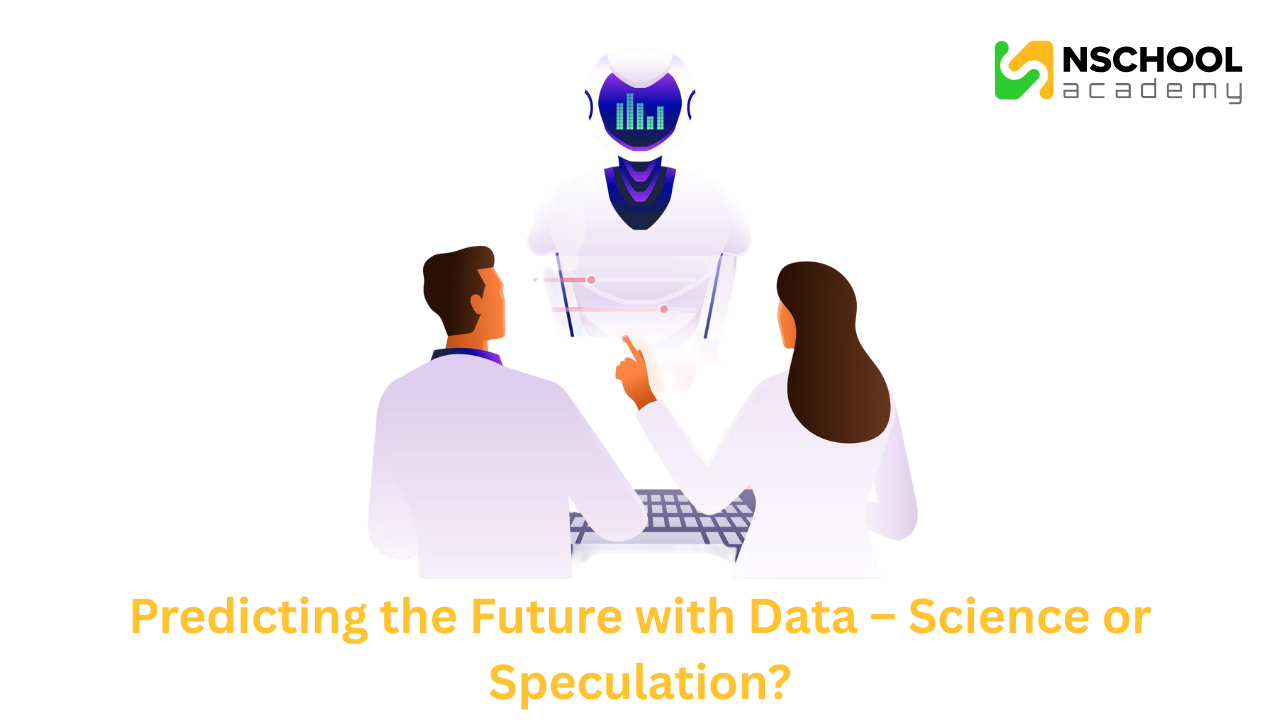Predicting the Future with Data – Science or Speculation?
- July 4, 2025
- nschool
- 0

Predicting the Future with Data – Science or Speculation?
Today, we live in a world where algorithms tell us what to buy, help predict market changes, and even warn us about possible disease outbreaks. Data Science or Speculation This raises an important question: Can data science truly predict the future, or is it just smart guessing?
With the rise of big data, machine learning, and AI, both businesses and governments are depending more on predictive tools. But how reliable are these predictions? And how can we tell the difference between real data insights and just assumptions?
In this blog, we’ll explore how data science tries to predict what’s next, look at real-world examples, and find out where science ends and speculation begins.
What is Prediction in Data Science?
In simple terms, prediction in data science means using past data to guess what might happen in the future. It looks at patterns from before and now to make smart guesses about what’s coming next.
These predictions can be:
- Classification-based (e.g., will a customer churn or not?)
- Regression-based (e.g., how many units will sell next month?)
- Time-based forecasting (like predicting stock prices or how many people will visit a website)
- Anomaly detection (e.g., identifying unusual credit card transactions)
Under the hood, predictions are powered by algorithms like decision trees, support vector machines, neural networks, and ensemble models — trained on large volumes of labeled data.
Science: The Power Behind Predictive Models
Data science isn’t just intuition wrapped in code. It is grounded in statistics, mathematics, and computer science. The models data scientists use go through rigorous steps like:
- Data cleaning and preprocessing
- Feature selection and engineering
- Model training and cross-validation
- Checking how well a model works using measures like RMSE, ROC-AUC, precision, and recall.
This scientific method makes sure that predictions can be measured, repeated, and tested — which are key parts of good science.
For example, in healthcare, prediction tools help hospitals know if a patient might need to come back or even spot diseases like cancer early. In finance, these tools can catch fraud or guess stock prices with good accuracy.
These real-life examples show that when used the right way, data science can make very accurate predictions — sometimes even better than human guesses.
Speculation: The Limitations of Prediction
Even though data science uses a scientific approach, it still has its limits. These models can’t actually see the future — they just make guesses based on past information.
Here’s where speculation creeps in:
1. Garbage In, Garbage Out (GIGO)
If the data used is unfair, missing important parts, or old, the prediction won’t be accurate. For example, if a loan approval model learns from biased past data, it could end up treating people unfairly — even if that’s not the goal.
2. Black Swan Events
Unexpected events, like pandemics or political crises, are usually too hard for any model to predict. No matter how smart the algorithm is, data science can’t accurately guess things that have never happened before.
3. Overfitting and Underfitting
Some models might do really well on the data they were trained with but fail when given new data. This means the model has “memorized” the training data instead of truly learning from it — a common problem called overfitting.
4. Data Drift
As people’s behavior, trends, and situations change, a model’s accuracy can also change. For example, a sales prediction model made before a big event like COVID-19 might not work well afterward.
So, even though predictions use scientific methods, how reliable they are depends on the situation, the data quality, and what the model assumes.
Real-World Examples: Data Science or Speculation
Predictive Success: Weather Forecasting
Today’s weather models use live data from satellites, radar, and sensors, along with years of past weather records. Because of data science, weather forecasts for the next 3 to 5 days are now more than 90% accurate — a great example of successful prediction.
Predictive Failure: The 2008 Financial Crisis
Even with plenty of financial data, most models failed to predict the 2008 housing market crash. This happened because the models were based on assumptions that didn’t consider extreme market changes or risky lending practices.
Are We Predicting or Just Guessing Better?
The honest answer: both.
Prediction in data science is not about seeing the future like a crystal ball. It’s about increasing the probability of being right using data-backed insights.
Unlike speculation, data science prediction:
- Uses repeatable, measurable methods
- Provides probabilistic confidence intervals
- Can improve over time with better data and models
Still, every prediction should be treated as a hypothesis — not a guaranteed outcome. A 90% confidence interval still means 1 in 10 times it may be wrong.
Where It’s Headed: Smarter, Not Perfect
New trends are making data science predictions stronger:
- Explainable AI (XAI): Helps make model decisions clear and easy to understand.
- Federated learning: Training models using data from different sources without sharing the actual data, helping to keep it private.
- Reinforcement learning: Allowing models to learn dynamically from interaction
- Causal inference: Understanding cause-effect relationships, not just correlations
These innovations push prediction from mere speculation toward actionable intelligence.
Conclusion: Data Science is a Compass, Not a Crystal Ball
So, is using data science to predict the future real science or just guessing?
It’s science — if used correctly. But it can turn into guessing if people ignore the data’s context, limits, or ethical issues.
Data science won’t let us see the future like fortune-tellers. But it gives us a strong tool — like a compass — to help businesses make smarter decisions in uncertain times.

